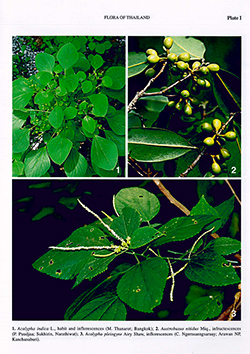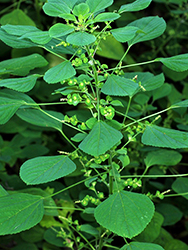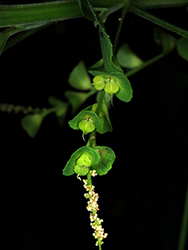e-Flora of Thailand
Volume 8 > Part 1 > Year 2005 > Page 26 > Euphorbiaceae > Acalypha
4. Acalypha indica L.wfo-0000953231
Sp. Pl.: 1003. 1753; Müll.Arg. in DC., Prodr. 15(2): 868. 1866; Hook.f., Fl. Brit. Ind. 5: 416. 1887; Forbes & Hemsl., J. Linn. Soc. Bot. 26: 438. 1894; Pax & K.Hoffm. in Engl., Pflanzenr. IV. 147. xvi: 33. 1924; Ridl., Fl. Malay Penins. 3: 274. 1924; Gagnep. in Lecomte, Fl. Indo-Chine 5: 336. 1925; Backer & Bakh.f., Fl. Java 1: 490. 1963; Airy Shaw, Kew Bull. 26: 206. 1972; Whitmore, Tree Fl. Malaya 2: 51. 1973; Radcliffe-Smith, Kew Bull. 28: 526–528, fig. 1G. 1974; Airy Shaw, Kew Bull. Add. Ser. 8: 18. 1980; Perry, Med. Pl. E. & South E Asia: 136. 1980; Airy Shaw. Kew Bull. 36: 247. 1981; Sen, Ecol. Approaches Ind. Weeds: 75. fig. 2, 30. 1981; Airy Shaw, Kew Bull. 37: 3. 1982; Keng, Concise Fl. Singapore: 105. 1990; Philcox in Dassan. & Fosberg., Rev. Handb. Fl. Ceylon 11: 132. 1997. Plate I: 1.
Accepted Name : This is currently accepted.
Synonyms & Citations :
Description : Annual herb, 15–90 cm high; stem erect, terete, longitudinally grooved, pubescent. Stipules narrowly triangular, 1–2 mm long, margin with glandular hairs. Leaves: petiole terete, 2.5–7(–8) cm long, pubescent; blade rhomboid, 3–7 by 2–6(–7.5) cm, chartaceous, base cuneate, margin crenulate-serrate, apex acute or obtuse, glabrous on both surfaces except veins pubescent, nerves in 4–5 pairs. Inflorescences 1(or 2) together, bisexual, axillary (to terminal), (2–)4–9(–11)cm long, staminate part apical, 0.5–1.5cm long, pistillate flowers at base. Staminate flowers 6–10 per node; bracts ovate-oblong or ovate-lanceolate, 0.8–1 by 0.2–0.3 mm, pubescent outside; buds subglobose, 0.3–0.7 mm in diam.; pedicel 0.1–0.2 mm long; sepals 4, ovate, ca 0.5 by 0.3 mm, glandular outside, puberulous. Pistillate flowers 1(–4) per node; bracts cup shaped, 4–9 by 5–13 mm, remotely serrate with 8–12 teeth, glabrous inside, pubescent outside, visible venation, translucent dots; sepals 3, ovate, 0.7–1.5 by 0.3–0.5 mm, pubescent glandular hairs; ovary subglobular, ca 1.5 mm in diam., pubescent; stigmas 2–3.5 mm long. Fruits 3 lobed, oblate or subglobular, 1.8–2.2 by 2–2.8 mm, pubescent, with glandular hairs. Seeds ovoid, 1.2–1.5 by ca 1 mm. Sometimes solitary irregular pistillate flowers at the end of the branches; pedicel 0.5–5 mm long; sepals 3 or 4, ovate-lanceolate, pubescent; style 1, attached at base of ovary, apex fimbriate; ovary 1-locular; fruit indehiscent, oblate, 2–3 by ca 2 mm, pubescent, with longitudinal suture in the center, appendages tubular at apex, 0.8–1 mm wide, fimbriate apically.
Thailand : NORTHERN: Mae Hong Son, Chiang Mai, Lampang, Phitsanulok, Kamphaeng Phet, Nakhon Sawan; NORTH-EASTERN: Maha Sarakham, Khon Kaen; EASTERN: Chaiyaphum, Nakhon Ratchasima, Buri Ram, Surin, Si Sa Ket, Ubon Ratchathani; SOUTH-WESTERN: Uthai Thani, Kanchanaburi, Ratchaburi, Phetchaburi, Prachuap Khiri Khan; CENTRAL: Lop Buri, Phra Nakhon Si Ayutthaya, Saraburi, Nakhon Pathom, Pathum Thani, Nakhon Nayok, Nonthaburi, Krung Thep Maha Nakhon (Bangkok); SOUTH-EASTERN: Sa Kaeo, Prachin Buri, Chachoengsao, Chon Buri, Chanthaburi; PENINSULAR: Chumphon, Surat Thani, Krabi, Nakhon Si Thammarat, Phatthalung, Trang, Songkhla, Narathiwat.
Distribution : U.S.A. (Guam), Tropical Africa, India, Sri Lanka (lectotype), China, Japan, Taiwan, Indochina, Malaysia, Singapore, the Philippines, Sumatra, Java, Lesser Sunda Islands, Timor, Sulawesi.
Ecology : Weeds in cultivation, along roadsides, 0–300 m alt.
Vernacular : Tamyae tua phu (ตำแยตัวผู้), tamyae maeo (ตำแยแมว)(Central); han maeo (หานแมว)(Northern); lang ta kai (ลังตาไก่)(Trang).
Uses: It is used as medicinal plant (citation in Perry!).



